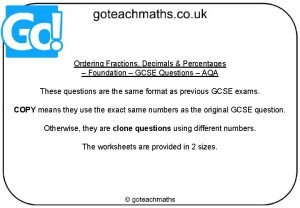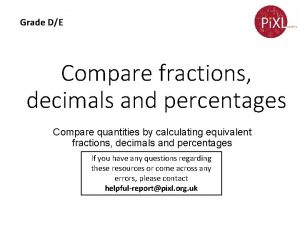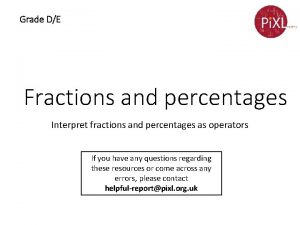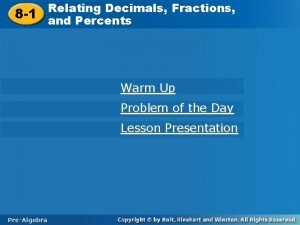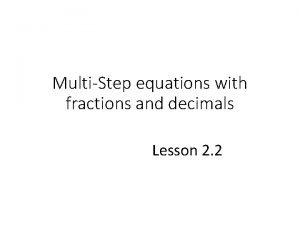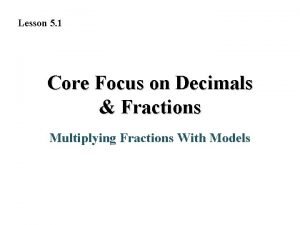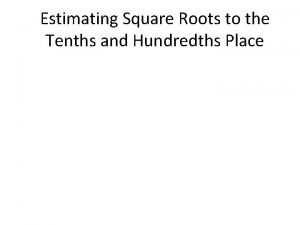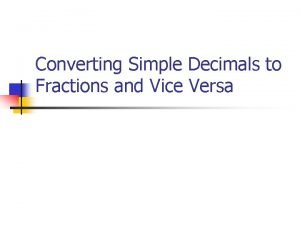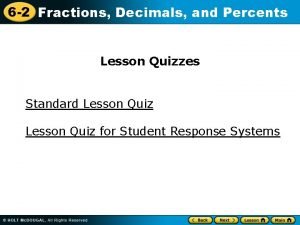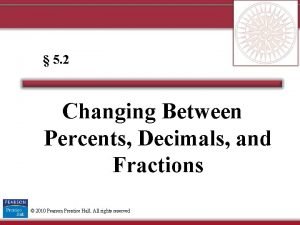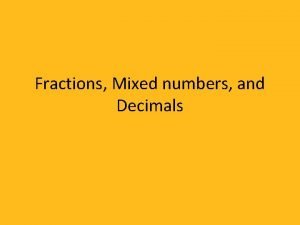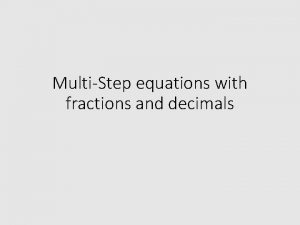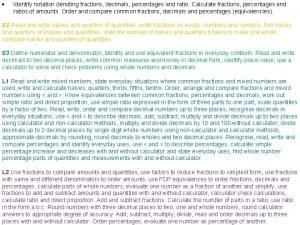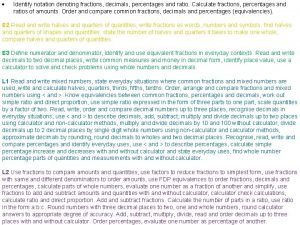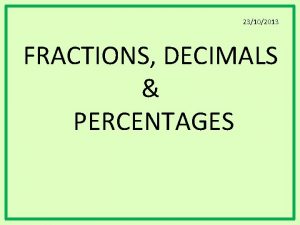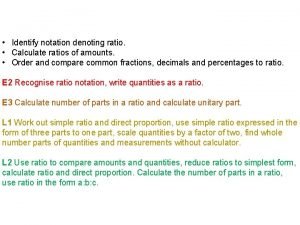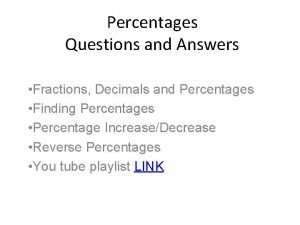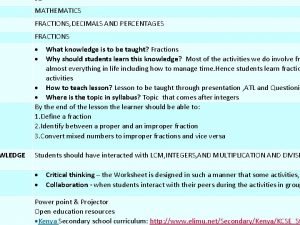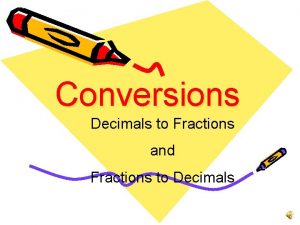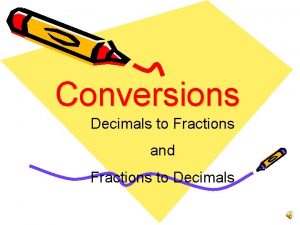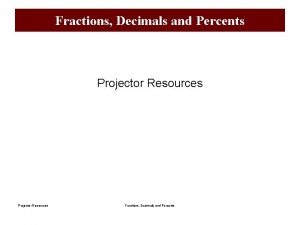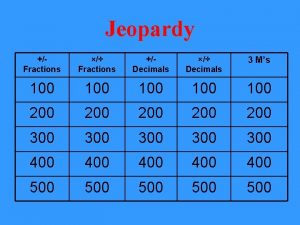Identify notation denoting fractions decimals percentages and ratio























- Slides: 23

Identify notation denoting fractions, decimals, percentages and ratio. Calculate fractions, percentages and ratios of amounts. Order and compare common fractions, decimals and percentages (equivalencies). E 2 Read and write halves and quarters of quantities, write fractions as words, numbers and symbols, find halves and quarters of shapes and quantities, state the number of halves and quarters it takes to make one whole, compare halves and quarters of quantities. E 3 Define numerator and denominator, identify and use equivalent fractions in everyday contexts. Read and write decimals to two decimal places, write common measures and money in decimal form, identify place value, use a calculator to solve and check problems using whole numbers and decimals. L 1 Read and write mixed numbers, state everyday situations where common fractions and mixed numbers are used, write and calculate halves, quarters, thirds, fifths, tenths. Order, arrange and compare fractions and mixed numbers using < and >. Know equivalencies between common fractions, percentages and decimals. Read, write, order and compare decimal numbers up to three places, recognise decimals in everyday situations, use < and > to describe decimals, add, subtract, multiply and divide decimals up to two places using calculator and non-calculator methods, multiply and divide decimals by 10 and 100 without calculator, divide decimals up to 2 decimal places by single digit whole numbers using non-calculator and calculator methods, approximate decimals by rounding, round decimals to wholes and two decimal places. Recognise, read, write and compare percentages and identify everyday uses, use < and > to describe percentages, calculate simple percentage increase and decreases with and without calculator and state everyday uses, find whole number percentage parts of quantities and measurements with and without calculator. L 2 Use fractions to compare amounts and quantities, use factors to reduce fractions to simplest form, use fractions with same and different denominators to order amounts, use FDP equivalences to order fractions, decimals and percentages, calculate parts of whole numbers, evaluate one number as a fraction of another and simplify, use fractions to add and subtract amounts and quantities with and without calculator, calculator check calculations, . Add and subtract fractions. . Add, subtract, multiply, divide, read and order decimals up to three places with and without calculator. Order and percentages in different situations, quick methods, evaluate one number as a percentage of another.

• Non-calculator warm up Fractions • Identify fractions game • Fractions and unifix cubes • Pair calculating fractions • Co-Ed(s) present to support with reading, writing, encouragement and maintaining focus • Coloured paper available • Variety of tasks/games for reinforcement • Peer support • Everyday fractions • Fraction increase and decrease • Identify common fractions • Order fractions by size • Compare equivalent fractions, decimals and percentages • Calculate fractions without calculator with numerator 1 • Calculate fractions without calculator where numerator is not 1. • • Class charter Equipment Books Any timetable changes, absences etc • Pair fraction word problems • • Everyday application of topics Peer support Find and correct errors Evaluate shortcomings or potential issues • Prove and disprove ideas and methods • Levelled tasks • Power. Point • Maths. Bot • PPt games – Connect 4, Countdown, Play Your Cards Right etc. • Stationery and Maths books • Identifying mistakes in own work • Less reliance on support and encouragement • Providing peer support without realising • Contributing to class discussions and providing answers • Faster response to questions • Clear interest • Referring back to previous notes • Percentages

This week: • Non-calculator practice • Fractions Carly Hill Maths

Why do I need to know this? • Also helps to understand percentages and decimals • Helps understand equivalencies between fractions, decimals and percentages When will I need to use this? • Rounding and estimating • Working with money • Calculating price increases and decreases

Challenge Beginner 5 +2 -6 +4 -1 x 2 +2 Medium 3 +5 -6 x 2 -1 ÷ 3 x 6 Advanced 15 -6 triple Square half it ÷ 50 it + 91 it

What is the answer? 8– 6= 9÷ 3= 14 ÷ 2 = 4 + 16 = 5 x 3= 124 - 76 = 1081 – 193 = 47 x 6 = 172 ÷ 4 = 4092 + 126 =

2 sweets are shared equally between 2 people: Each person gets ½ the sweets. 2÷ 2=1

10 sweets are shared equally between 2 people: Each person gets 1/2 the sweets. 10 ÷ 2 = 5

6 sweets are shared equally between 2 people: Each person gets ½ the sweets. 6÷ 2=3

12 sweets are shared equally between 2 people: Each person gets ½ the sweets. 12 ÷ 2 = 6

8 sweets are shared equally between 2 people: Each person gets 1/2 the sweets. 8÷ 2=4

11 sweets are shared equally between 2 people: Each person gets ½ the sweets. 11 ÷ 2 = 5. 5

Fractions • Half: ½ • ÷ 2 What is half of 8? What is half of 16? What is half of 24? What is half of 14?

Quick Check… • What is ½ of 18? • What is ½ of 6? • What is ½ of 2? • What is 1/2 of 20? • Which is 1/2 of 4? • What is 1/2 of 24?

12 sweets are shared equally between 4 people: Each person gets ¼ of the sweets. 12 ÷ 4 = 3

8 sweets are shared equally between 4 people: Each person gets ¼ of the sweets. 8÷ 4=2

4 sweets are shared equally between 4 people: Each person gets ¼ of the sweets. 4÷ 4=1

Fractions • Quarter: ¼ • ÷ 4 What is a quarter of 8? What is a quarter of 16? What is a quarter of 24? What is a quarter of 14?

Quick Check… • What is ¼ of 20? • What is ¼ of 24? • What is ¼ of 60? • Which is ¼ of 16? • What is ¼ of 8?

Fractions • The top number of a fraction is called the numerator • The bottom number of a fraction is called the denominator • To work out ¼ of 20: divide by the bottom number: • 20 ÷ 4 = 5 • To work out ¾ of 20: divide by the bottom number, times by the top number: • 20 ÷ 4 = 5, then 5 x 3 = 15


Fractions

Fractions • Increase 20 by ½ • Decrease 20 by ½ • Increase 28 by ¼ • Decrease 28 by ¼ • Increase 50 by 1/10 • Decrease 50 by 1/10 • Increase 60 by 1/3 • Decrease 60 by 1/3
 Ordering fdp
Ordering fdp Ordering fractions decimals and percentages
Ordering fractions decimals and percentages Ordering fractions and decimals
Ordering fractions and decimals Where can you find percentages in everyday life
Where can you find percentages in everyday life Compare fractions decimals and percentages
Compare fractions decimals and percentages Percentages as operators
Percentages as operators Lesson 6 compare and order fractions
Lesson 6 compare and order fractions Dividing fractions by decimals
Dividing fractions by decimals Order positive and negative integers decimals and fractions
Order positive and negative integers decimals and fractions Percentages fractions
Percentages fractions Two-step equations with decimals and fractions
Two-step equations with decimals and fractions Lesson 5 decimals and fractions
Lesson 5 decimals and fractions Hundredths square
Hundredths square Changing decimals to fractions and vice versa
Changing decimals to fractions and vice versa Compare fractions and decimals
Compare fractions and decimals Christmas fraction
Christmas fraction 6-2 relate fractions decimals and percents
6-2 relate fractions decimals and percents Lesson 6-2 fractions, decimals, and percents answers
Lesson 6-2 fractions, decimals, and percents answers Lesson 6-2 fractions, decimals, and percents answers
Lesson 6-2 fractions, decimals, and percents answers Converting between percents decimals and fractions
Converting between percents decimals and fractions Converting between percents decimals and fractions
Converting between percents decimals and fractions Fractions decimals and percents calculator
Fractions decimals and percents calculator Writing mixed numbers as decimals
Writing mixed numbers as decimals How to get rid of fractions in an equation
How to get rid of fractions in an equation

